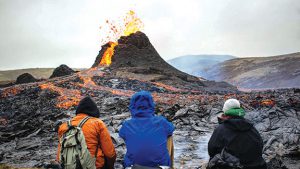Bloomberg
As volcanic activity in Iceland starts, the country’s tourism industry kicked into high gear, grasping an opportunity to revive the business after the pandemic had banished most visitors from the Atlantic island for more than two years.
With reports emerging of sightings of lava, the shares of Icelandic airlines Icelandair hf and Fly Play hf, which flies under the banner Play Air, began ticking up. Within hours of magma emerging, Play Air was already advertising the eruption on its website, describing it as “peaceful†and “picturesqueâ€.
The island nation, which calls itself the land of fire and ice, already has experience of how a volcano captivates imaginations and prompts travellers to book trips into the country. An explosive 2010 eruption under the Eyjafjallajokull glacier spewed out a magnificent ash plume, capturing world’s attention as it grounded about 100,000 flights over six days, and eventually turned tourism into one of the Nordic nation’s biggest industries.
In contrast, the current fissure eruption on the Reykjanes peninsula causes no disruption to travel, and is what the Icelanders call a “tourist volcano,†where lava flows from a rift in the ground in a relatively accessible location near roads. That’s tempting onlookers to approach, even as authorities warn of toxic gases and seismic activity.
The area previously saw lava streams last year — the first in that area of the country in 800 years, sparking local businesses to begin offering tours to visitors. Some people even fried hot dogs as well as marshmallows on the lava, according to reports.
The 2021 “spectacle attracted thousands of locals and tourists excited about a (possibly) once-in-a-lifetime show,†Icelandair said in a blog on its website. “We expect that the 2022 eruption will have a similar magnetic appeal.â€
 The Gulf Time Newspaper One of the finest business newspapers in the UAE brought to you by our professional writers and editors.
The Gulf Time Newspaper One of the finest business newspapers in the UAE brought to you by our professional writers and editors.
